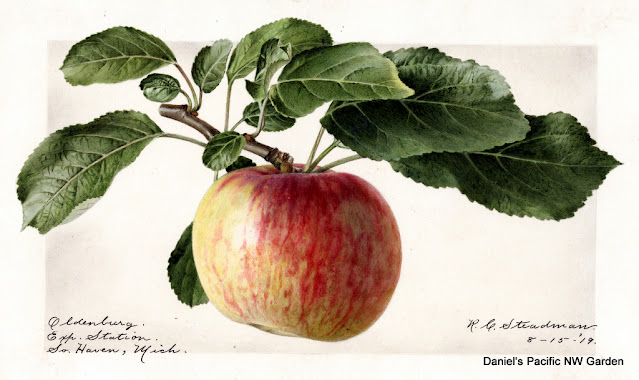Honeycrisp. Everyone knows this one. I have tried it before. It is not easy. It will go on one of the minidwarfs that I decided to overgraft.
Gala. A relatively modern apple (1934 if that is modern) with an excellent flavor originally from New Zealand. Ripens in Winter and is a keeping apple. Gala is a cross of Kidd's Orange Red and Golden Delicious. Kidd's Orange Red is a cross of Cox's Orange Pippin and Delicious. Cox is the classic English apple that gives some of its descendants a more tropical, aromatic flavor. I don't know if that "Delicious" is "Red Delicious" - I read it is not "Golden Delicious", anyway.
Duchess of Oldenberg. A historic apple, originally from Russia. Ripens late Summer.
Otterson. A smaller, tart, highly red flesh juice apple with some astringency. This apple is for coloring apple juices red by increasing the anthocyanin content. Ripens in Fall, per Fedco. Probably late 20th century.
William's Pride. Modern PRI disease resistant apple. Ripens in early August. (Fall, per Fedco). Williams Pride has a complex lineage, with the only grandparent that I recognize as Jonathan. Five generations back there is Rome and Malus floribunda 821, the source of its scab resistance. The pollination event that created William's Pride was in 1973 at the University of Illinois in Urbana, IL. Described as a Summer dessert apple.
Opalescent. Historic apple. Ripens in Fall per Fedco.
Dana Hovey Pear - a winter pear. This is my first knowledge of "winter pears". Will it be easier to know when they are ripe? An Experiment.
--------------------------------------------------------------------
Of these apples, only Opalescent and Duchess of Oldenburg are historic variety (more than 100 years old). This is an image of Opalescent from the U.S. Department of Agriculture Pomological Watercolor Collection. Rare and Special Collections, National Agricultural Library, Beltsville, MD 20705 (attribution required by the web site)
I edited this image slightly to increase contrast and color resolution, and edited some of the margins to make the image more visible.
According to Apples of North America, by Tom Burford, Opalescent originated in 1880 when George Hudson found the seedling while digging out stumps in Barry County, Michigan. It stores well. It has susceptibility to apple diseases. I have a small branch of Opalescent on a dwarf multigraft. I like the apple, nice sweet flavor. I decided to include this in my scion order because I'm not confident that if I take a cutting from my multigraft, that it will be the right one. According to Trees of Antiquity, Opalescent was once widely grown in New England.
Duchess of Oldenberg, from the same USDA Pomological Website as above. According to Fedco, Duchess of Oldenburg was imported in 1835 along with other Russian apples. It was named for the sister of Czar Alexander, Catherine Pavlovna. Described as scab resistant, which is good in my garden. Considered one of the best for pies and sauce. As quoted from Apples of New York in Trees of Antiquity, these apples "Kept up the hope of prairie orchardists in times of great discouragement". According to Wikipedia, Duchess of Oldenburg dates to the era of 1750 - 1799.


No comments:
Post a Comment
Note: Only a member of this blog may post a comment.